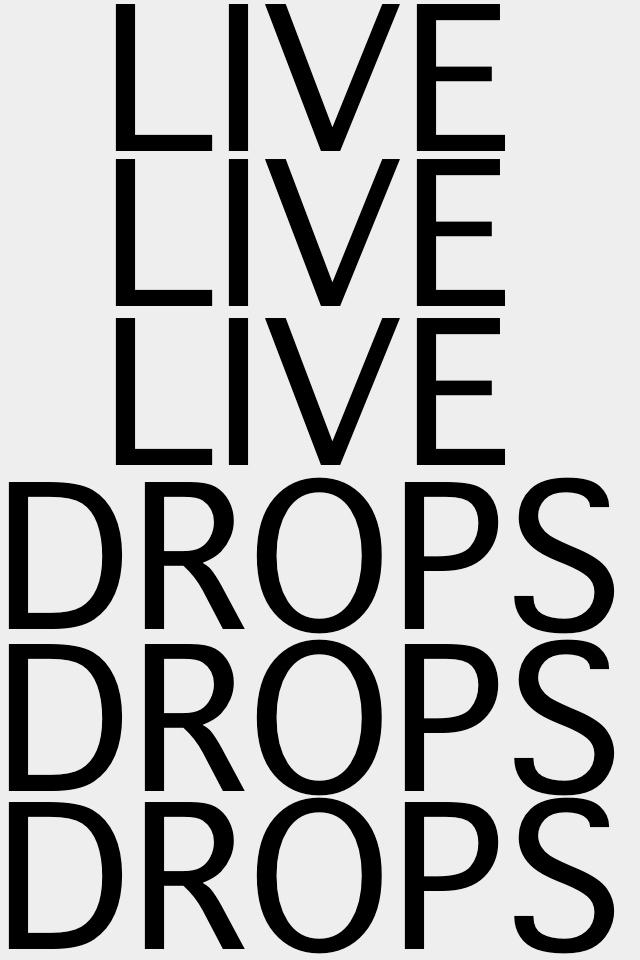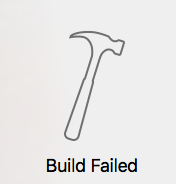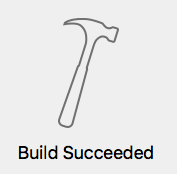LIVE DROPS
by: Frederick Corless & Leo Petrokofsky
LIVE DROPS ©™ is an iphone application game that gets the user searching the environment around them to find specific colour coded patterns. The user cannot cheat and play this game, the only way to access and play the content is by unlocking it, and to unlock it they must go out into the big wide world and find the coloured pattern codes. The app contains 4 mini-games at the present time. Ghost Walker, Whole My Balls, Library Labyrinth and Toilet Time. Ghost Walker is a mini game where the player has to collect items whilst trying to survive by avoiding ghosts. Whole my balls is a simple but tricky game involving getting a ball into a hole. In Library Labyrinth the player must escape the library by collecting at least two of their unreturned books and their missing library card, all whilst avoiding the angry librarians that shoots lightning out of their fingertips. Toilet Time is a sound and colour based playback memory game where the user must remember what colours equate to which sounds and play them back in the correct order to complete the game. These games are unlocked if and when the user finds colour coded patterns that are hidden somewhere in the real world around them. The user will be able to find where these patterns are by following written clues or hints. Only once a mini-game has been completed will a clue for the next color pattern code be revealed. When they find the pattern, they can scan it with their phone's camera and the game linked with that pattern is then unlocked and is then playable.


Aims, Audience and Research.
We looked into Dead drops, as inspiration for real a world based physical location interaction. Dead Drops a project created, in 2010 by Aram Bartholl, a media artist from Berlin as a way to anonymously share anything peer to peer without the use of the internet.
USB flash drives are embedded into walls, buildings and curbs accessable to anybody in public space.Plug your laptop to a wall, house or pole, where these usbs have been embedded, to share your favorite files and data. By creating a dead drop, sharing seems more communal, and maybe more relevant to the area it’s in. People are encouraged to upload anything they like to the dead drops, photos of themselves, share work, music, information.
Along with research into Drops Drops part of our research has been looking at procedural generation of games. Procedural generation is a process by which data is created algorithmically rather than manually. We used Derek Yu's Spelunky as a bench mark of how to make a relatively simple game and idea as enjoyable as possible through the use of procedural generation
One notable app that we took inspiration from is InkHunter, which uses simple shape recognition on a smartphone camera and then overlays a pre-chosen design onto the position where the shape has been drawn. InkHunter uses smiley face shape recognition to trigger augmented realisty tattoos onto objects. We, took this idea as a basis for our icon recognition for how to unlock content in the Live Drops app.
As you can see LIVE DROPS has taken a large influence from our research into dead drops. We wanted to utalise the idea of physical location relating to data and information. Our adaptation therefore was to make them live, not dead, by making the outcome of the interactions fun and interactive.
So, from this research the aim was to appeal to everyone, there wasn’t a specific audience in mind that we think wouldn’t be able to participate. The only limit is that it is only available on iphone and not android systems. We don’t expect the audience to be experienced gamers, or have any level of experience regarding iphone apps. We intended LIVE DROPS to be easily understood and self explanatory.
Building on LIVE DROPS we have considered following similar ideals to the Dead Drops project where people can add their own mini-games, along with their own codes, and join the LIVE DROPS community.
For the mini-games we wanted to follow in the footsteps of classic arcade style games, with 8bit graphics.


The obvious starting point for aestetics was how the app looks at first sight on the users homescreen, so we went through a process of creating and choosing the best looking icon, and loading screen aestetics.
Creative Process
Since our project is such an an amalgam of all the ideas running through both of our heads. Our creative process was quite a disorganised affair, with both of us working on the aspects of the app that had most recently taken our interest.
We both spent a lot of time learning how to use Adobe Illustrator over the course of our app creation. Leo: to include the dark and light sprites and texture overlays present in the Dark Maze game, Fred: to create the icons and logos that looked aesthetically pleasing with the simple style that we both envisioned.
Our app involves a mixture of pre-set and randomized aspects. The Dark Maze game, for example, is entirely pre-set rather than with all the values and positions of objects hard-coded in to the app, rather than procedureally generated as initially planned (largely so we didn't have to learn the layout to a new labyrinth every time we made a change to the game that we needed to test). Whereas, the Joke Generator and the Ghost Walker game are both randomized so as to not get boring too quickly on repeat viewing and playing.
All of our game sprites were taken from OpenGameArt and Journey to the Center of Hawkthorne. OpenGameArt is a brilliant crowd-sourced website for artists to put art and sprites they create for game developers free to use as long as they credit the original artist. Journey to the Center of Hawkthorne is a game created by fans of the tv show Community with free to use sprites and sounds.


Difficulties.
An error we often encountered was having linker errors, through lots of googling and asking questions on the stackoverflow forum, to which there were many answers, however often none specific to our ios/iphone related queries. Through mainly trial and error we were able to overcome these hurdles. More than once the solution for Freddie was to redownload the ios OpenFrameworks libraries and folders.
When combining our respective sections of work, as we expected, wasn't as straightforward as hoped. However, many of the issues we were faced with stemmed from missing header search paths or incorrect includes. Once we sorted these out we were able to deal with the errors that ineviteably popped up methodically until we had a working product.
Leo had to remove the sound track and additional sounds during his work on the Ghost walker and Library Labyrinth mini-games because when we ported from openFrameworks to ios OpenFrameworks the sound files were causing latency issues and slowing down the gameplay, due to the limited capabilities of the mobile ram and cpu, due to the large file sizes of the audio.
Another problem we encountered was that we wanted to have the text consistently center aligned in the main menu to therefore create a consistent aesthetic, we overcame this by using an freely available addon for openFrame works called ofxTextSuit that allowed us to easy center align all of the text in simple function, rather than individually input coordinates.
The fact that we were working for ios was also an unexpected issue in itself. In a world where the iphone is one of the biggest smartphones on the market and the apple app store is the most popular mobile application marketplace, there is a lack of rhetoric and general information related specifically to ios OpenFrameWorks. This is because iphone development is done in Apple’s own Swift language. Our path to ios led us to use Objective-c and C++ and a combination of these languages called Objective-C++ which again, because of lack of research in this area compared with other languages has made debugged more difficult. User testing was an issue as apple make it quite difficult to become a developer, and because of this a beta test is not easily completed, as we couldn’t just install LIVE DROPS on testers phones, so we just had to let testers use our phones.


Evaluation.
We feel that LIVE DROPS is a successful amalgamation of both of our creative and technical inputs and abilities, as well as fulfilling our original intentions. We can see this from our user testing, where there is room for improvement, as with anything, it can be seen that our intentions have been met. Our testers can understand, participate and interact with LIVE DROPS with little to no training or learning. This, we think, is portentous to future success with a wider range of testers and users. Our mini-games, our user interface, and overall operation and interaction with the application work together in a coherent way. The way the application functions together makes us optimistic for its capabilities for community participation, where other developers can add their own mini-games or fun interactions, which only furthers our thoughts on success and even future prospects of developments.
GIT REPO
http://fcorl001@gitlab.doc.gold.ac.uk/lpetr001/liveDrops.git
http://lpetr001@gitlab.doc.gold.ac.uk/lpetr001/liveDrops.git
References
[1] Deaddrops websites - https://deaddrops.com/
[2] Stackoverflow - https://stackoverflow.com/
[3] Iosopenframeworks - http://openframeworks.cc/setup/iphone/
[4] ofxTextsuit - https://github.com/Furkanzmc/ofxTextSuite
[5] Journey to the Center of Hawkthorne - https://projecthawkthorne.com/
[6] Open Game Art - https://opengameart.org/
[7] Maze Generator - https://www.youtube.com/watch?v=HyK_Q5rrcr4&t
[8]Dark and Light Sprite creation - https://www.youtube.com/watch?v=PO_5eMVE0z4&t
[9] Spelunky - http://spelunkyworld.com/
[10] Dark Maze Mac Repo - https://github.com/lpOX4G/Dark-Maze-Mac
[11] Twitter link to LIVE DROPS - @LPFC9










































































